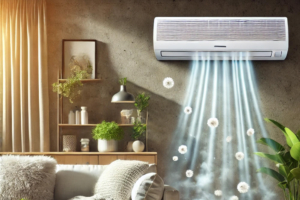The Role of HVAC in Allergy and Asthma Management
 Allergies and asthma are common health issues that affect millions of people worldwide. For those suffering from these conditions, managing their symptoms is a daily challenge. One critical yet often overlooked factor in controlling allergies and asthma is the home’s HVAC (heating, ventilation, and air conditioning) system. A well-maintained HVAC system can significantly reduce the presence of allergens and improve indoor air quality, making a noticeable difference for those with respiratory issues. In this blog post, we’ll explore how your HVAC system can play a pivotal role in allergy and asthma management and provide practical tips to optimize your home environment.
Allergies and asthma are common health issues that affect millions of people worldwide. For those suffering from these conditions, managing their symptoms is a daily challenge. One critical yet often overlooked factor in controlling allergies and asthma is the home’s HVAC (heating, ventilation, and air conditioning) system. A well-maintained HVAC system can significantly reduce the presence of allergens and improve indoor air quality, making a noticeable difference for those with respiratory issues. In this blog post, we’ll explore how your HVAC system can play a pivotal role in allergy and asthma management and provide practical tips to optimize your home environment.
Understanding Allergens and Triggers
Before diving into the HVAC system’s role, it’s essential to understand what allergens and asthma triggers are. Allergens are substances that can cause an allergic reaction. Common indoor allergens include:
- Dust mites: Tiny bugs that thrive in household dust.
- Pet dander: Tiny flakes of skin shed by cats, dogs, and other pets.
- Mold: Fungi that grow in damp environments.
- Pollen: Microscopic grains released by plants.
- Cockroach droppings: Particles from cockroach feces.
Asthma triggers can overlap with allergens but also include irritants like tobacco smoke, strong odors, and changes in weather.
The Importance of Indoor Air Quality
Indoor air quality (IAQ) refers to the air quality within and around buildings and structures, especially as it relates to the health and comfort of building occupants. Poor IAQ can exacerbate allergy and asthma symptoms, making it crucial to maintain a clean and allergen-free home environment.
How HVAC Systems Impact Indoor Air Quality
Your HVAC system plays a central role in maintaining indoor air quality. Here’s how:
- Filtration: HVAC systems are equipped with filters that trap dust, pollen, and other airborne particles. High-efficiency filters, such as HEPA (High-Efficiency Particulate Air) filters, can capture up to 99.97% of particles, including those as small as 0.3 microns.
- Humidity Control: Proper humidity levels are essential in preventing mold growth and dust mites. HVAC systems with built-in humidifiers or dehumidifiers can help maintain optimal humidity levels, typically between 30-50%.
- Ventilation: Fresh air is crucial for diluting indoor pollutants. Modern HVAC systems can improve ventilation by bringing in outdoor air and exhausting indoor air, reducing the concentration of allergens and irritants.
- Temperature Regulation: Maintaining a consistent indoor temperature can reduce the likelihood of mold growth and minimize the presence of dust mites, both of which thrive in warm, humid environments.
Tips for Optimizing Your HVAC System for Allergy and Asthma Management
- Regular Filter Changes: Change your HVAC filters every 1-3 months, or as recommended by the manufacturer. Consider using HEPA filters for maximum efficiency in trapping allergens.
- Duct Cleaning: Have your HVAC ducts cleaned periodically to remove dust, mold, and other contaminants that can accumulate over time. Professional duct cleaning services can help ensure thorough cleaning.
- Routine Maintenance: Schedule annual maintenance for your HVAC system. A professional technician can inspect and clean components, ensuring your system operates efficiently and effectively.
- Humidity Control: Use a hygrometer to monitor indoor humidity levels. If necessary, install a whole-house humidifier or dehumidifier to maintain optimal humidity levels.
- Upgrade Your System: If your HVAC system is old or inefficient, consider upgrading to a newer model with advanced filtration and humidity control features. Modern systems are designed to provide better air quality and energy efficiency.
- Use an Air Purifier: In addition to your HVAC system, consider using portable air purifiers with HEPA filters in high-traffic areas or bedrooms to further reduce allergens.
- Seal Leaks: Ensure your home is well-sealed to prevent outdoor allergens from entering. Check for gaps around windows, doors, and ductwork, and use weatherstripping or caulk to seal any leaks.
- Clean Regularly: Regular cleaning can significantly reduce indoor allergens. Dust surfaces with a damp cloth, vacuum carpets with a HEPA-filtered vacuum, and wash bedding in hot water weekly.
- Control Pets: If you have pets, keep them out of bedrooms and off furniture to minimize dander. Bathe and groom pets regularly to reduce shedding.
- Avoid Indoor Pollutants: Avoid using strong chemicals, tobacco products, and other indoor pollutants that can exacerbate asthma symptoms. Opt for natural cleaning products and ensure proper ventilation when cooking or using household products.
Conclusion
Managing allergies and asthma involves a multi-faceted approach, and your HVAC system plays a crucial role in this process. By ensuring your HVAC system is well-maintained and optimized for air quality, you can create a healthier home environment that minimizes allergens and irritants. Regular filter changes, humidity control, and routine maintenance are just a few of the steps you can take to improve indoor air quality. Remember, a clean and efficient HVAC system not only helps manage allergies and asthma but also contributes to overall comfort and well-being in your home.
At Jacobs and Rhodes, we understand the importance of a well-functioning HVAC system in maintaining a healthy home environment. Our team of experienced professionals is here to help you with all your HVAC needs, from installation and maintenance to upgrades and repairs. Contact us today to learn more about how we can help you improve your indoor air quality and create a safer, more comfortable living space.

 Jacobs and Rhodes
Jacobs and Rhodes Jacobs and Rhodes
Jacobs and Rhodes